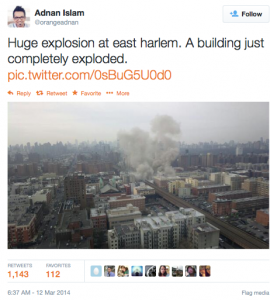With the widespread use of social media, people often learn about emergencies via Twitter faster than they do on breaking television news or from official government news sources. In fact, these traditional news sources often get their information from social media and follow up to verify and report information.
Obviously, the advantage of sharing information via social media is that the faster people have information, the faster they can respond. However, a disparate media landscape means that misinformation can also spread quickly, or that different sources may report different information, contributing to confusion.
This was the experience for some in the wake of the gas explosion in East Harlem. While emergency responders and established organizations like the Red Cross adhered to their procedures, other groups like the Certified Emergency Response Team weren’t clear about their roles or where the most reliable information should come from. Participants in the April 26th community conversation held at the CUNY School of Public Health, these volunteers among them, emphasized the need for reliable, central communication channels during an emergency.
One interesting approach recently put into place in New Orleans makes use of personal health data to identify people with special needs and tailor responses to them. The New York Times recently reported on a pilot program that used Medicare data to target vulnerable individuals who may need extra help, such as people using breathing equipment. Officials from the program visited people in their homes to gauge the accuracy of the information they were able to gather from records and to get people’s reactions.
As journalist Sheri Fink wrote in the article,
“the program is just one of a growing number of public and corporate efforts to take health information far beyond the doctor’s office, offering the promise of better care but also raising concerns about patient privacy.”
While this program focused on visiting people in person, elsewhere, other digital and social media are being used to augment health care, such as text messages that alert parents that their children need to get vaccinations.
But making use of personal health records raises privacy about using “big data” to reveal information people many not want shared. The pilot program conducted in New Orleans adhered to privacy guidelines and, as the article described, most people who were approached welcomed the help. However, the widespread use of digital media and the kind and amount of data we share, inadvertently or otherwise, has shaken up our ideas and expectations about privacy. The Health Information Portability and Accountability Act, more commonly referred to as HIPPA, and procedures of informed consent (i.e. all of those long forms you fill out at the doctor’s office) were designed to protect people’s personal health information from anyone other than themselves, their medical providers, and others with special permission, such as a family member. But those laws were drafted before digital media became so integrated in our everyday lives and before we thought about the potentials and pitfalls of vast stores of data.
Could (or should) a program like the one in New Orleans work in East Harlem? How could it reach the whole community, especially those with special needs? Are there other models to follow? How could people’s privacy be protected? How could clear communication channels be designed given the many outlets for information?





Pingback: Record of the Week (Week of 19 May 2014) « STS Turntable